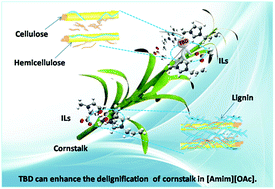Enhanced delignification of cornstalk by employing superbase TBD in ionic liquids†
Abstract
The delignification of cornstalk was efficiently accomplished by using 1,5,7-triazabicyclo[4.4.0]dec-5-ene (TBD) as an additive in 1-allyl-3-methylimidazolium acetate ([Amim][OAc]). When 1.0 wt% TBD was added to [Amim][OAc], the cellulose and lignin contents of cellulose rich material (CRM) were achieved to be 39.12% and 6.74%, respectively. With the addition of 0.1 wt% TBD to [Amim][OAc], the lignin content of CRM could even be reduced to 2.06% without considering the cellulose content. There could be two possible reasons for the enhanced delignification of cornstalk by adding TBD in [Amim][OAc]. One is the alkalinity and exposed nitrogen atoms of TBD, which make it an efficient dibasic nucleophile and helpful for the lignin β-O-4 ether bond cleavage reaction. The other one is the decreased interaction energy of [Amim]+ and [OAc]− from 99.1 kcal mol−1 to 89.2 kcal mol−1 with the addition of TBD, which makes the [Amim]+ and [OAc]− easier to interact with the cornstalk components. Simultaneously, the CRM regenerated from the system of [Amim][OAc] + TBD was effectively hydrolyzed by cellulase with 98% enzymatic hydrolysis yield, which proved that the cellulose structures were highly disrupted and lignin was significantly removed in the CRM.


 Please wait while we load your content...
Please wait while we load your content...